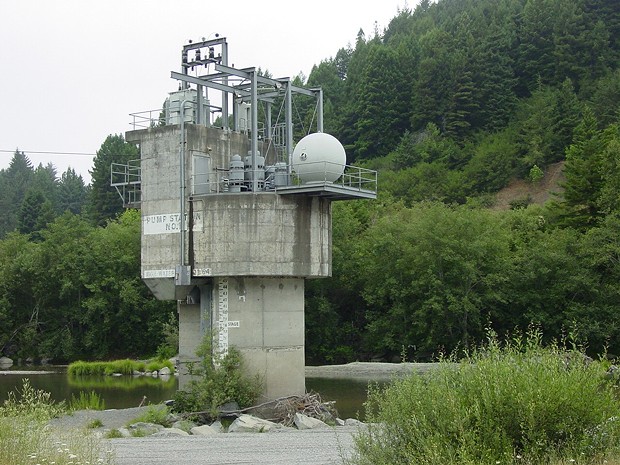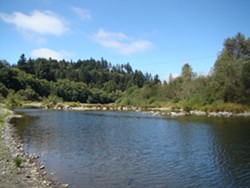
Courtesy of the Humboldt Bay Municipal Water District
One of the Humboldt Bay Municipal Water District wells in the Mad River that draw water from the aquifer under the riverbed.
[
{
"name": "Top Stories Video Pair",
"insertPoint": "7",
"component": "17087298",
"parentWrapperClass": "fdn-ads-inline-content-block",
"requiredCountToDisplay": "1"
}
]
If you've read stories about the disaster afflicting Flint, Michigan, you are probably grateful we still have good drinking water in Humboldt County. But the agency that provides water to a majority of county residents is increasingly worried about the future and going head-to-head with the county Planning and Building Department to protect water quality.
About half of Humboldt's residents get drinking water from the Mad River, including Eureka, Arcata and McKinleyville. The water is of unusually good quality, coming from the river's bed, where it is naturally filtered through layers of sand, and the Humboldt Bay Municipal Water District (HBMWD) says its mission is to maintain that water quality. But the district fears changes in the county zoning code could open up properties in the Mad River watershed to increased industrial uses that could pose a threat to the district's water source.
"The Humboldt Bay Municipal Water District is concerned about the cumulative effects of increased industrial activities within the Mad River watershed and the potential impacts to our water quality that the district provides to approximately 88,000 residents of Humboldt County," District General Manager John Friedenbach wrote in a June 13 letter to the Humboldt County Board of Supervisors. "Zoning text amendments that expand and broaden the principally permitted industrial uses should be weighed against the environmental and health threats inherent in those activities and whether it is in the public's interest and welfare to expand those activities in environmentally sensitive areas."
This isn't the first time the district has raised alarms about potential threats to water quality in the Mad River. Last year, neighbor Mercer-Fraser Co., which has operated a gravel mine adjacent to the river for decades, asked the county to change its zoning to industrial so that it could open a cannabis extraction business on the site, which many feared would expose the river to dangerous chemicals. After a lot of public backlash, Mercer-Fraser withdrew its application.
Other cannabis extraction facilities in the Mad River watershed have also applied for permitting. The HBMWD usually asks the planning commission to deny these permits while citing concerns about its ability to maintain the purity of the river water.
But the issue of immediate concern to the district stretches far beyond a single permit application.
The county planning department and the board of supervisors are currently going through the contentious task of re-writing the zoning code so that it will conform to the 2017 General Plan Update. This process has re-ignited numerous political brushfires that plagued the county for the past 20 years throughout the GPU process and, although the effort has been going on for several months, little progress has been made.
Most of the parcels adjoining the Mad River are currently zoned Agricultural-Exclusive (AE). Despite the name, AE allows several non-agricultural uses, including surface mining. Another common rural agricultural land use designation, Agricultural-General (AG), allows oil and gas drilling, as does the Timber Production Zone (TPZ).
After several months of squabbling, the planning commission and the board have yet to come to a clear agreement as to what can and cannot be done in these zones.
HBMWD is currently lobbying the board for broader protection of the Mad River watershed. The district was particularly concerned about a phrase that would have permitted "historical" uses by legitimizing any current industrial activities in a streamside management area, even if those uses were illegal or unpermitted at the time. The word "historical" was finally removed by the board at its June 18 meeting, although mining remains as an allowable use.
Friedenbach has sent the county numerous letters detailing his concerns. Letters and emails sent to the commission in March and April did result in the commission agendizing the issue for discussion. In another letter sent to the board June 13, Friedenbach states that the general plan shows surface mining as incompatible in Agricultural-Exclusive or Timber Production zones and questions whether the impacts of allowing such uses were studied in the GPU's environmental impact report.
The June 13 letter to the board followed one sent a week earlier that raised alarm about the perceived threat to the region's drinking water from principally permitting "historic" uses.
"These activities pose a continuing threat to our community's health and water security, and the district continues to be concerned that the zoning ordinance will be revised to summarily permit previously unpermitted activities or prior potentially illegal activities rather than be used as a forward-looking tool to adequately protect the health, safety and welfare of your constituents," Friedenbach wrote. "The zoning text amendments must be in the public interest to be adopted ... however, to the extent that the proposed revisions allow changes in uses that may detrimentally impact drinking water quality, they are not in the public interest."
While the board would ultimately agree to drop the provision allowing historical uses to continue, Friedenbach now believes he has found a better path forward than continuing to scramble to provide piecemeal protections for the 75-mile long Mad River watershed.
Browsing through the General Plan, he discovered a section under the Water Resources Element that specifically protects watersheds that are critical to providing water to communities. Only two such watersheds were mentioned: Francis Creek, which supplies the city of Ferndale, and Luffenholz Creek, which supplies the city of Trinidad.
Friedenbach reasoned that the Mad River, which supplies Eureka, Arcata and McKinleyville, should qualify for similar protection.
At the July 11 meeting of the water district board, Third District Supervisor Mike Wilson and Fifth District Supervisor Steve Madrone, as well as county supervising planner Michael Richardson, were present in the audience to listen to and comment on the proposal to list the Mad River as a "Critical Water Supply Area."
Both of the supervisors indicated they thought the idea had a lot of merit. Madrone pointed out that in addition to the historical problems with surface mining and illegal diesel storage, illegal cannabis production was adding to the environmental problems facing the river. But he warned them that "time is of the essence" in getting the zoning code changed to protect the Mad River watershed.
Wilson and Richardson walked the water district through the complex process of getting an issue heard by the board, urging them to first go through the planning commission and to ask the policy-makers to give the matter priority over the long list of other zoning amendment changes.
"It's not the only thing we have to do," Wilson commented with characteristic understatement.
The water district has been including its attorney on recent correspondence with the county. (Actually, the county is facing so many implied and overt threats of litigation over the zoning code amendments that county counsel, at the board's July 9 meeting, advised the supervisors to hold off on taking further action until the legal issues raised could be thoroughly studied.)
For their part, the water district and Friedenbach seem poised to continue pressing to make protecting the Mad River watershed — and the 88,000 people who depend on it for drinking water — a priority as the process moves forward.
"The district believes that protecting water quality, which is one of the stated primary purpose(s) of establishing standards within the county's general plan, should receive a higher priority during your deliberations regarding the proposed zoning text amendments," Friendebach wrote in the June 13 letter.
Elaine Weinreb is a freelance journalist. She tries to re-pay the state of California for giving her a degree in environmental studies and planning (Sonoma State University) at a time when tuition was still affordable.
Comments (4)
Showing 1-4 of 4
more from the author
-
Trouble on the Mountain
A popular outdoor recreation area is also a makeshift shooting range, causing growing safety concerns
- Jan 11, 2024
- More »
Latest in News
Readers also liked…
-
Through Mark Larson's Lens
A local photographer's favorite images of 2022 in Humboldt
- Jan 5, 2023
-
'To Celebrate Our Sovereignty'
Yurok Tribe to host gathering honoring 'ultimate river warrior' on the anniversary of the U.S. Supreme Court ruling that changed everything
- Jun 8, 2023
































